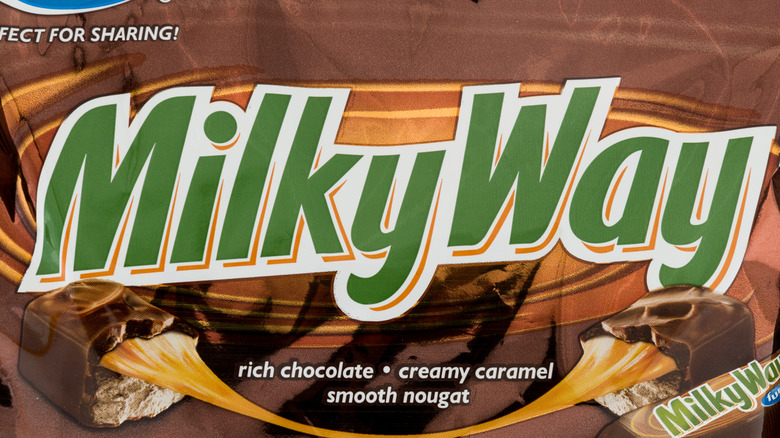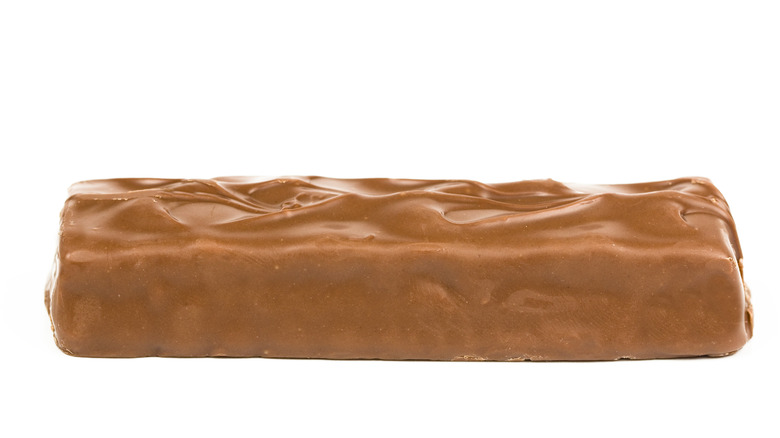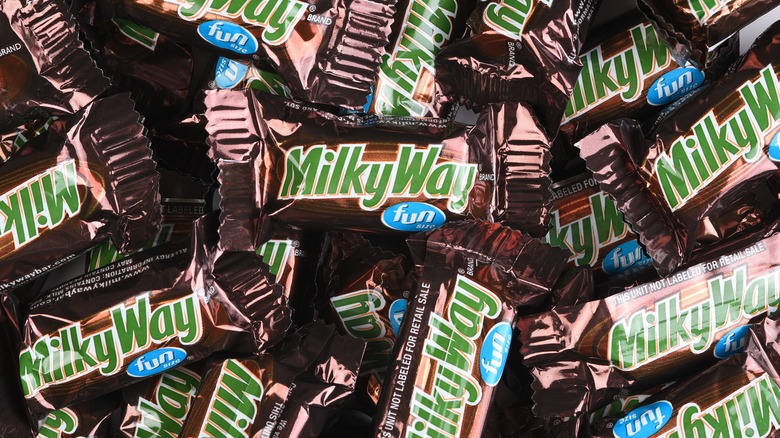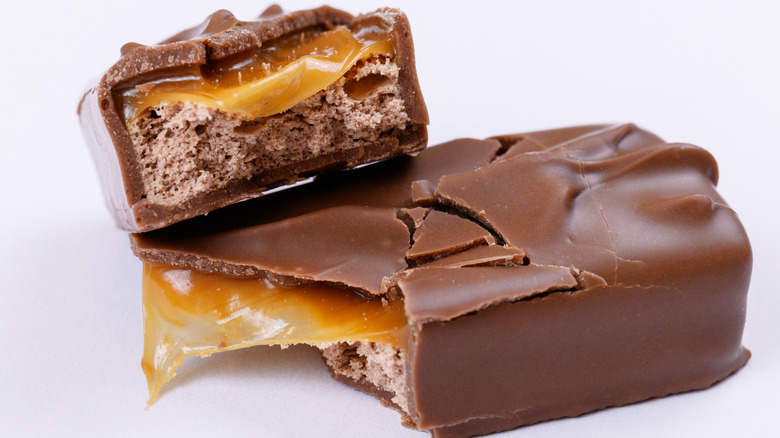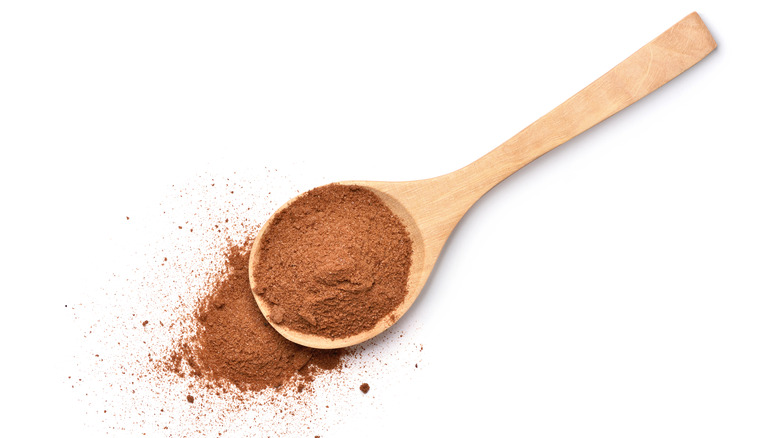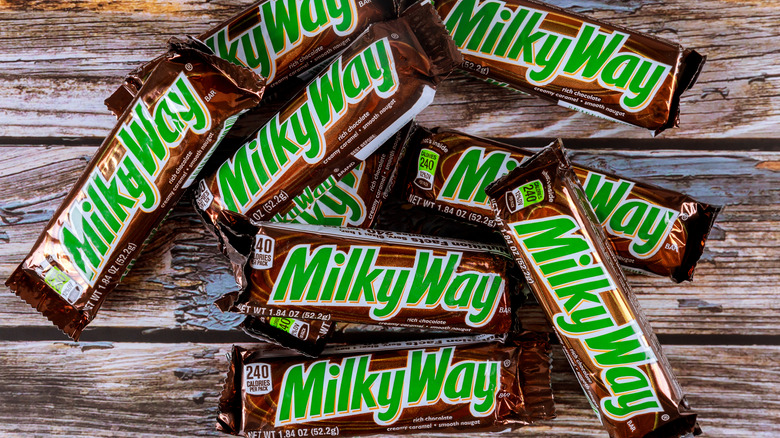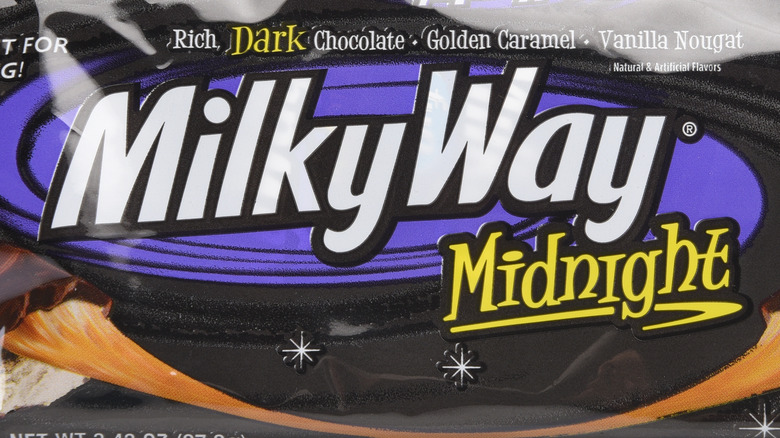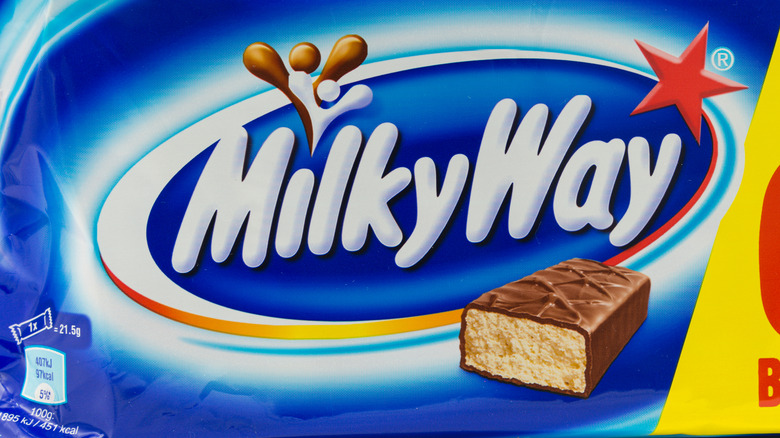The Untold Truth Of Milky Way
We may receive a commission on purchases made from links.
There's a small number of candy bars that are not only entrenched in the collective American consciousness, but in the retail sector, too. Just about every grocery store, convenience store, gas station, and newsstand in the country is sure to have on hand some Hershey bars, Snickers, Reese's Peanut Butter Cups, and, of course, Milky Way. The chocolate-covered treat that shares its name with a galaxy has been selling steadily if not astronomically since its debut nearly 100 years ago. It's signature brown, green, and white wrapper promises a tasty combination and ideal ratio of chocolate, nougat, and caramel within. Long before most other chocolate brands were stuffed with nuts or some other texture-providing addition, the three-part Milky Way was one of the first ever "combination bars."
The beloved Milky Way has rightfully earned its place in American and food history. Here's just about everything there is to know about this sweet and creamy institution.
Milky Way is based on previously existing candy
In the mid-1910s, according to Minneapolis' Southwest Journal, candy maker Raymond Pendergast founded the Pendergast Candy Company. Its most lasting contribution to candy was the creation of "Minneapolis Nougat," an airy, fluffy, spongy, marshmallowy filling. It was notably used as the basis for its popular candy bar the Fat Emma — a thick rectangle of nougat coated in chocolate. Around the time the Fat Emma started to sell, fledgling Minneapolis chocolatier Franklin Mars cut into Pendergast's market, introducing the Mar-O-Bar. Mars would name his whole company Mar-O-Bar after his successful product (later adopting his full surname for his enterprise). Print-ads touted the Mar-O-Bar tasted "just like whipped cream covered with milk chocolate." In other words, it was kind of like modern nougat, but a more rudimentary form of it.
In 1923, Mars incorporated Pendergast's Minneapolis Nougat into the basic Mar-O-Bar template, and along with some other changes, he created an altogether new candy bar he called the Milky Way.
Milky Way's inventor got the idea from his son
Combining traits of the Fat Emma and Mar-O-Bar isn't the only Milky Way origin story — or at least not the whole of it. In 1923, according to Joanne Mattern's "Mars Family," Franklin Mars became reacquainted with his son, Forrest Mars, whom he hadn't seen since 1910, when the younger was six years old, following a divorce. Forrest Mars was working as a traveling salesman and was arrested in Chicago for postering a block's worth of buildings with handbills. When Franklin Mars got wind of the incident, he went to Chicago to bail his son out. To have some place to sit and talk, they went to a soda fountain and ordered some chocolate malted milkshakes. Forrest then reportedly gave his candy maker father an idea: Take the taste of chocolate, malted milk, and milkshake, and put them into a candy bar. The elder Mars liked it, and upon returning to Minneapolis, he combined malt-flavored nougat with caramel and coated the whole package in chocolate.
By 1924, this new treat, Milky Way, was on store shelves. And not just locally; according to Beth Kimmerle's "Candy: The Sweet History," the chocolate encasement kept the caramel and nougat from souring, allowing it to be transported across the country and still taste fresh.
Milky Way has changed a lot
Within a year of its launch, more than $800,000 worth of Milky Ways had been sold (via "Mars Family"). At 5 cents each, that means over 16 million bars were consumed. Not only did the novelty of a portable malted milkshake entice consumers, but they were also charmed by perceived value. "People walked up to the candy counter and they'd see this flat little Hershey bar for a nickel and right next to it, a giant Milky Way," Forrest Mars said. "Guess which one they'd pick?" he asked rhetorically. Mars was implying that the answer would be the Milky Way, which weighed about 3 ounces in the early 20th century (versus 1.8 ounces in 2021) and boasted the thickness of about three standard Hershey bars (via Samira Kiwash's "Candy: A Century of Panic and Pleasure").
Not only has the weight of the Milky Way changed over the decades, but so has its composition. According to Candy Professor, the caramel layer constituted a very thin stripe (unlike the robust presence in a modern Milky Way). The reason: Nougat was cheaper to produce, consisting of just eggs, sugar, and air. Until the mid-1960s, the chocolate that covered the caramel and nougat was made by Hershey, Mars' biggest rival. But when Forrest Mars took control of Mars Inc., he moved all chocolate coating production in-house, according to "The Oxford Companion to American Food and Drink."
Milky Way proudly touted its use of malted milk
Milky Way shares a name with the Milky Way galaxy, but the words have much more to do with dairy products than they do stars. After all, the original flavor inspiration for the candy was the triple dairy wallop of a soda fountain's malted milkshake, made up of malted milk, ice cream, and milk. The perceived goodness, wholesomeness, and healthiness of milk was the focus of Milky Way's marketing for decades. According to "Candy: A Century of Panic and Pleasure," as early as 1925, Mars' ad copy touted the "food value and eating qualities" of Milky Way with the addition of more malted milk to the recipe, giving the bar "more malted milk content than a soda fountain double malted milk."
However, malted milk isn't altogether a dairy product. It was conceived in the 1870s by pharmacist James Horlick, looking to invent an infant formula. The result was a powder made from wheat flour, barley, and evaporated whole milk. Thus, the implication from the Milky Way ads: Because it contained a lot of malted milk, it was healthier than the average candy bar — which is quite the stretch.
Milky Way ran afoul of the Federal Trade Commission
Taking a cue from its 1920s-era ads that implied the bar was healthy due to its malted milk content, commercials for Milky Way in the 1950s and 1960s suggested the product was good for you due to an abundance of real milk. One spot featured a child making an "M" (for "Milky Way" and "magic") gesture with his fingers, turning a full glass of milk into a Milky Way. Another commercial featured a narrator boasting that the candy is made "with gallons and gallons of fresh, whole, grade A milk." There was yet another (per "Candy: A Century of Panic and Pleasure") that showed a child eating the candy on a dairy farm, while the narrator promised that the product is "really good food that's good for you" because it's "loaded with farm fresh milk and the whipped up whites of country eggs."
The not-so-subtle message was that a Milky Way was just as nutritious as milk and eggs. But seeing as how it's a candy bar, those claims just aren't true. In 1970, the Federal Trade Commission ordered Mars to stop airing misleading ads about the dairy content of its candy.
When Milky Way went dark
Ignoring the old dictum of "If it ain't broke, don't fix it," the Mars company tinkered with Milky Way within three years of its extremely successful debut — and then kept tinkering with it. In 1926, according to OldTimeCandy.com, the chocolate-covered bar of caramel and chocolate-flavored, malt-suggesting nougat gained a partner in the form of a dark chocolate-coated vanilla nougat (and caramel laced) Milky Way variant. By 1932, Mars had abandoned the idea of two separate Milky Way lines and sold the two flavors in a two-part bar: one half chocolate-chocolate nougat, the other dark chocolate-vanilla nougat. Just four years after that, Mars went back to selling each type of Milky Way on its own; the original style was marketed under the flagship Milky Way name while the dark chocolate form was rebranded Forever Yours.
This Milky Way in everything but name stuck around stores, selling in modest enough quantities for a lifespan of more than 40 years. Mars, however, discontinued Forever Yours in 1979. But there were more fans of dark chocolate, nougat, and caramel than Mars figured. Catering to persistent demand, the company reintroduced the dark chocolate Milky Way in 1989 under the name Milky Way Dark. It's still sold today, but under yet another new name: Milky Way Midnight.
Milky Way looks different around the world
Milky Way is one of the best-known and longest available candy bars in the United States, alongside 3 Musketeers, Mars Bar, and Snickers, all of which fall under the Mars, Inc. banner. But outside of the U.S., these offerings may be available under different names or the same name but in different formulations. Milky Way in the U.S. consists of nougat and caramel covered in chocolate. According to Candyblog, that exact conglomeration is marketed in Europe and other locales as the Mars Bar. (Per Beth Kimmerle's "Candy: The Sweet History," Mars founder Frank Mars clashed with his son and partner, Forrest Mars, and sent him to Europe to expand the business. He introduced the Milky Way but made it sweeter to cater to local tastes.)
For decades, there was a Mars Bar sold in the United States, but that candy was essentially a Milky Way with almonds. (Another Mars favorite, Snickers, is a lot like Milky Way in that it contains chocolate, nougat, and caramel, but also peanuts; in the early 2000s, Mars got rid of the Mars Bar in America and replaced it with the nearly identical Snickers Almond.)
In the U.K., Milky Way is made up of chocolate covering a whipped nougat inside. There's no caramel present, which means a British Milky Way is much more like an American 3 Musketeers than it is an American Milky Way.
